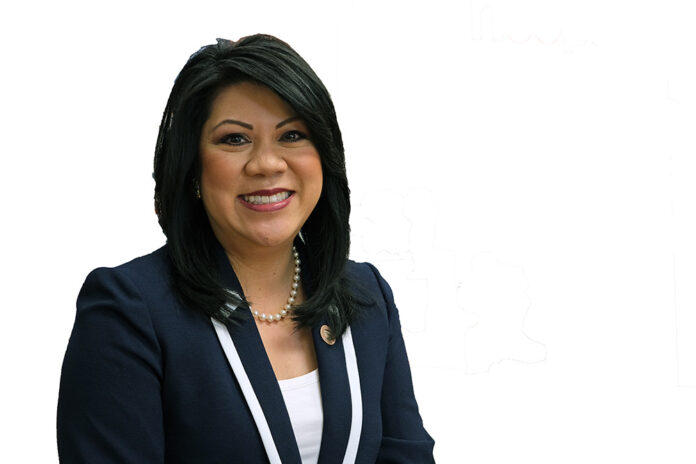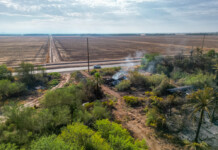
Kimberly Yee is in her first year as Arizona’s state treasurer after serving as a state lawmaker and speaking at the 2016 Republican National Convention. She sat down with InMaricopa to talk about a new Financial Literacy Task Force and the goals of her office to help Millennials and others understand their finances.
[quote_box_left]KIMBERLY YEE
Age: 45
Hometown: Phoenix
Education: Greenway High School, Pepperdine University majoring in English and political science, ASU master’s in public administration
Family: Husband and two children
Previous work: Deputy cabinet secretary for Gov. Arnold Schwarzenegger, policy analyst for Gov. Pete Wilson, executive team of Arizona State Treasurer Dean Martin, eight years as Arizona legislator in District 20, second woman (after Sandra Day O’Connor) to serve as Senate Majority Leader
Fun fact: She is the first Asian-American elected to the Arizona Legislature. She is the fifth-straight generation of her family to own a small business in the United States.[/quote_box_left]Remind us of your background and how you came to the State Treasurer’s Office.
I was born and raised in Arizona, so I grew up in Phoenix, Arizona, and went to Greenway High School, Pepperdine University for my undergrad. Majored in English and political science and earned my master’s degree in public administration from Arizona State University. One of the things I did right after college was start working for public policymakers. I had the privilege of working for two governors in California. I specifically chose education-related policies, so early on I worked on childcare and development issues, later serving for Gov. Arnold Schwarzenegger – I was his deputy cabinet secretary working on education-related issues. I came back to my home state to work for former state treasurer Dean Martin. He was our state treasurer for four years, back in 2007, ‘08, ‘09 and ‘10. It was a time where the state was going through a lot of financial-related issues, and the office was very helpful in trying to determine where our economic revenues were coming in and how they were being spent. We were able to use the Treasurer’s Office back then to warn the Legislature and the executive office that things were looking dim in the future, and from an economic forecast they needed to start spending down what they were previously spending on because the revenues were not coming in. Back then it was really the beginning of using the Treasurer’s Office for economic purposes in helping policymakers.
Were they listening?
Well, they did have our information available to them. Did they listen? No. Unfortunately, they didn’t. We asked them to spend $150 million less than they were spending, and then they created a budget that fiscal year to spend more than $150 million [more]. That’s not the way we anticipated they should go, but we did our due diligence by providing the information for them to know where we were in our budget and where we were in our economy.
[quote_center]”Well, they did have our information available to them. Did they listen? No.”[/quote_center]Now, fast-forward, around that same time, my state senator was looking to retire. So, it was a woman asking another woman to run for office, and I wanted to see if that became open and it did. I became a state House member first and then served in the Arizona Senate for three terms in District 20, which was northwest Phoenix, parts of Glendale. And I served as the senate majority leader in my last term. I was the second female to have that position since Sandra Day O’Connor served 44 years prior to that time. It was a real privilege to meet with Sandra Day O’Connor, the former justice, when she came to the Legislature and I invited her as my guest and we promoted civics education, which is a legacy she wanted to leave following her time on the bench.
This seems to be always circling back to education. What drew you to that in the first place?
My mother was a former schoolteacher in the public-school system in Phoenix for 38 years. It was easy for me to make that decision, because around the dinner table, as a young girl, we talked about education and the importance of making sure our kids have a high quality of education no matter what ZIP code they lived in. I carried that in my public policy behind the scenes working for elected officials, and then when I became elected that really was a priority for me and has been. So, I’ll continue working on education-related issues even out of the Treasurer’s Office.
Right off the bat, I promoted financial education in our schools, which is something that is very important. When I was working for State Treasurer Dean Martin 12 years ago, we were looking at our schools and unfortunately found we aren’t teaching kids the basics, these life skills, on how to manage their money. When I learned this wasn’t a requirement, while I was serving in the Legislature I tried to promote and sponsor legislation that would get us moving toward that direction. Early on in my legislative career, I sponsored a bill that requires the K-12 system to have academic standards which touch on financial education, age-appropriate of course. In kindergarten, a student can learn about savings in a piggy bank but have more concepts that are a little more complicated as they move on to high school. Simple skills that are really used once you get out into the real world.
[quote_center]”We were looking at our schools and unfortunately found we aren’t teaching kids the basics, these life skills, on how to manage their money.”[/quote_center]
Finally, at the end of my term, we look at how do we incentivize a high schooler to take classes that teach you these basic skills? Because these other classes are much more inviting, like golf and art. Who would take a business class or something that would teach these things? So, I created a little seal at the end of my time in the Senate that allows for a student who takes these courses to have a seal of proficiency for financial education. So, that really would help them if they take – even if it’s just one semester – a class that would allow them to get that seal on their graduation diploma. Once I became state treasurer, it was important to deal with it more. We really want to teach students in high school those basic life skills to ensure they understand how to balance a budget, balance their checkbook, what it means to carry credit month-to-month on their credit card. We had a bill put before the Legislature that has now become law that requires a student who is in their econ semester to be taught financial education within that time period. They would have curriculum that would be embedded in that econ semester that teaches them these basic skills.
Is this going to be part of the Financial Literacy Task Force?
The Task Force will move forward to create more ideas. This was already done in my first six months and it’s now law, so this will be the first academic year that will be administered. We have a long line of items we want to continue to work on. I created a task force of 16 members, 17 including myself – I chair the task force – first-ever in the state that brought together experts in this field, individuals who will represent not only our K-12 system to advance educational options for financial education but also other vulnerable communities like our senior citizens who are on fixed-income budgets. Our veterans and those who have served in the military, we have a representative on their behalf.
We have teachers, we have individuals who represent vulnerable populations, for instance single-parent homes and those who are struggling to find jobs. We also wanted to be sure to hit a number of these groups who are dealing with issues in their finances, to provide them with a toolbox, resources that are free that will help them get on their feet. One of the reasons why we’re in Maricopa today is to talk to a group that will be able to advance that through nonprofit work. It’s exciting for me. This will be a priority for my administration. It’s something I’ve been passionate for over a decade.
How did you find the members of the task force?
A number of them I worked with over my time in the Legislature, those eight years working on bills that advance financial education in our schools but also looking at what we can do next. In talking to various groups, we need to open doors for individuals to find easy-to-find resources – something that’s free of cost. We need to put it into one place. I thought, “What better way to bring everybody together at one table for the first time.”
Our meeting was fantastic when we first met face-to-face. We have a lot of work to do. We’re going to provide proposals on how we’re going to roll this out in all these various communities. I’ve just come back from a treasurer’s conference where I’m learning from other states what they’ve done. We’re borrowing ideas, we’re looking for ideas. We have it open to the public so we can hear from others who aren’t at the table.
[quote_center]”When these young kids come out into the real world, they have to learn how to manage their money or it will affect your neighborhood.”[/quote_center]
I think this is very important because if affects everybody. When these young kids come out into the real world, they have to learn how to manage their money or it will affect your neighborhood. We are looking at our Millennial population in particular, because these are young people who we see, the evidence shows, are $1.6 trillion in student debt. Roughly 39 percent of the Millennial population say they don’t pay their bills on time. That’s a significant number. If we keep going down that road, we will really be in trouble from an economic perspective. So, this is a conversation we should have had years and years ago, but let’s have it now.
After your years in the Treasurer’s Office, to come back as the treasurer yourself, did you find surprises there?
In a good way. There was very little transition time because I already knew the office and how it works. At the very beginning I wanted to create new structure in terms of our organizational chart. I moved various divisions into areas that fit better in terms of operations and performance from our investment side.
As you know, we manage roughly $40 billion in the state’s cash management of the budgets going in and out of the agencies throughout the year. We have roughly $17 billion in assets under management in our office. This provides investments for local governments, local jurisdictions that would like our office optionally to invest their dollars. It was important for me to look at what other administrations had done, what their performance has been in those areas, what we can do that can be improved. One of the things I wanted to improve was our local government investment pool.
[quote_center]”If we maximize every single dollar, that’s really what matters. That’s what people elected me to do.”[/quote_center]
These are optional choices that local governments can make, but if they see that our returns are doing great, which they are, and they want to invest those local dollars, that means more to local taxpayers, which means more money for infrastructure, education, transportation. I want to provide that eye-to-eye conversation with our local leaders. I have been going out on the road, talking to mayors and council folks because they need to know when we’re managing their funds, that we’re doing a great job at it and we have various portfolio options they can continue to use or advance.
If we maximize every single dollar, that’s really what matters. That’s what people elected me to do. I’m looking out for the state level but for the local dollars as well. I also want to use the office to continue to advance our economic forecasts because what we see coming in and out of the office really does matter to the policymaker, whether it be at the state level or even at the local level, how they’re going to plan their out-going budgets year to year. If we can provide the information and that can be helpful to them, I’d like to use that economic forecast for their purposes.
How well do you think the average Arizonan understands what your office does?
I think probably not a lot of people know what the Treasurer’s Office does. That has been another goal of mine. I’ve been [making] the office available for tours, for children to come in to see what we do. It’s something I’m proud of. This office has done such great, great work over so many decades, and we need to acknowledge that from the taxpayers’ perspective. In fact, our investors in our office, they manage the state land trust proceeds. So, anytime state lands are sold, the proceeds come immediately to our office and investors invest that money, and most of it goes to K-12 education. That is something most people probably don’t know, but it’s important because the numbers are significant.
[quote_center]”Anytime state lands are sold, the proceeds come immediately to our office and investors invest that money, and most of it goes to K-12 education.”[/quote_center]
What we invest goes right back into the K-12 system. As an example. All of the state lands that were sold in the last fiscal year, in this fiscal year 2020, which just began, we are going to roll out $342 million to the K-12 system on top of what they’ve already received from the legislative appropriations. Those are investments that came out of our office from the state lands sold. That is one that I would like to share, but also to talk about how well the investments have performed.
We really take a careful look at how we invest. It’s always safety first, because these are tax dollars. If you were to look at our long-term investments over 10 years, over a billion dollars, and you were to compare the National Association of College and University Business Officials that ranks the biggest endowments across the country, we out-performed Yale, Stanford, Columbia and Harvard, all of the big universities. We ranked in the 95th percentile. It shows that our office has done very, very well in its investment performance on behalf of the taxpayers
This article appears in the August issue of InMaricopa.

![Maricopa restauranteur makes Food Network connection [Namkeen Dhaba]](https://www.inmaricopa.com/wp-content/uploads/2024/04/439456716_377105198650519_7536248579664805896_n-218x150.jpg)









![Maricopa’s ‘TikTok Rizz Party,’ explained One of several flyers for a "TikTok rizz party" is taped to a door in the Maricopa Business Center along Honeycutt Road on April 23, 2024. [Monica D. Spencer]](https://www.inmaricopa.com/wp-content/uploads/2024/04/spencer-042324-tiktok-rizz-party-flyer-web-218x150.jpg)

![Maricopa restauranteur makes Food Network connection [Namkeen Dhaba]](https://www.inmaricopa.com/wp-content/uploads/2024/04/439456716_377105198650519_7536248579664805896_n-100x70.jpg)


